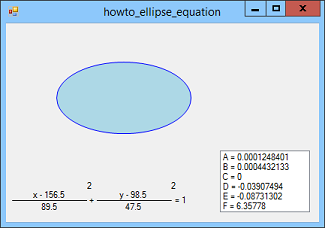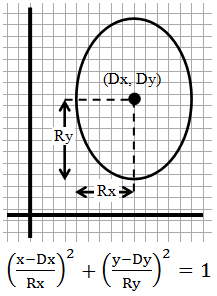![[C# Helper]](../banner260x75.png)
|
|
 |
![[Beginning Database Design Solutions, Second Edition]](db2_79x100.png)

Title: Calculate the formula for an ellipse selected by the user in C#
This is example is very similar to Calculate the formula for a circle selected by the user in C# except it shows how to calculate the formula for an ellipse instead of a circle. See that post or download the example program for information about how the program lets the user select the shape and how the program draws the selected shape.
After the user selects an ellipse, the program averages the minimum and maximum X and Y coordinates to find the center of the ellipse (Dx, Dy). It then divides the ellipse's width and height by two to get the parameters Rx and Ry. It can then display the equation.
Like the previous example that draws circles, this example verifies the function by using the Graphics object's FillEllipse method to fill the ellipse and then drawing the points on the ellipse calculated by using the function.






Download the example to experiment with it and to see additional details. |
![[Beginning Software Engineering, Second Edition]](book_sw_eng2_79x100.png)
![[Essential Algorithms, Second Edition]](book_algs2e_79x100.png)
![[The Modern C# Challenge]](book_csharp_challenge_80x100.jpg)
![[WPF 3d, Three-Dimensional Graphics with WPF and C#]](book_wpf3d_80x100.png)
![[The C# Helper Top 100]](book_top100_80x100.png)
![[Interview Puzzles Dissected]](book_interview_puzzles_80x100.png)
![[C# 24-Hour Trainer]](book_csharp24hr_2e_79x100.jpg)
![[C# 5.0 Programmer's Reference]](book_csharp_prog_ref_80x100.png)
![[MCSD Certification Toolkit (Exam 70-483): Programming in C#]](book_c_cert_80x100.jpg)

 The big difference between the two examples is that this example uses the equation for an ellipse not a circle. The picture on the right shows the geometry for an ellipse with major and minor axes parallel to the X and Y axes.
The big difference between the two examples is that this example uses the equation for an ellipse not a circle. The picture on the right shows the geometry for an ellipse with major and minor axes parallel to the X and Y axes.
 The equations on the left show how you can convert the normal form of the equation into a function that gives y in terms of x. As is the case with a circle, the result includes two equations that use positive and negative square roots.
The equations on the left show how you can convert the normal form of the equation into a function that gives y in terms of x. As is the case with a circle, the result includes two equations that use positive and negative square roots.